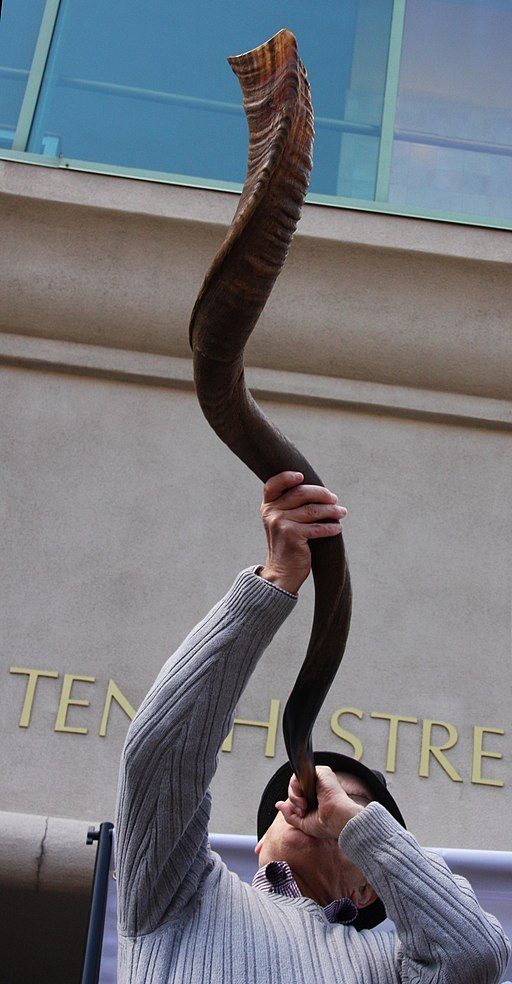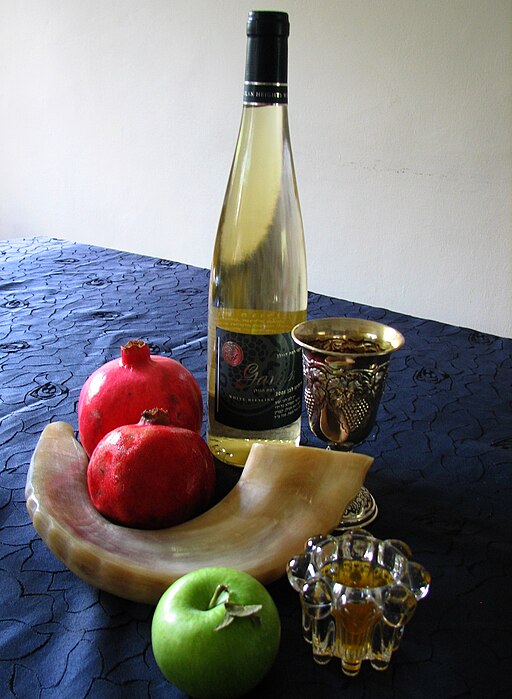A man blows the shofar.
Names are written in books.
And an apple is eaten.
Welcome to Rosh Hashanah, the Jewish New Year
- What is Rosh Hashanah?
- What does Rosh Hashanah mean?
- What are the origins of Rosh Hashanah?
- How do you celebrate Rosh Hashanah? What are the rituals and traditions of Rosh Hashanah?
- When is Rosh Hashanah?
What is Rosh Hashanah?
Rosh Hashanah is the Jewish New Year, that is the first day of the year. It is also the first of the Jewish High Holy Days (Days of Awe).
Surprisingly, Rosh Hashanah is celebrated on the first and second days of the seventh month of Hebrew calendar, the month of Tishrei.
This means that usually the holiday is celebrated during September or October.
So how can it be the start of a new year, if it is celebrated on the seventh month? Easily – since there are four different days marking new years in the Hebrew calendar.
Rosh Hashanah is for calculating calendar years as well as sabbatical and jubilee years.

What does Rosh Hashanah mean?
In Hebrew, “Rosh” means “head” or “first”, “Ha” means “the” and “shanah” means “year”. So Rosh Hashanah translated to Head of the year or First of the year.
Rosh Hashanah marks the traditional anniversary of the creation of Adam and Eve, the first man and woman according to the Hebrew Bible, and the inauguration of humanity’s role in God’s world.
So it is a celebration of life.
Or is it?
The Jewish New Year is also referred to as Day of Judgement. Why?
Because according to tradition, three books of account are opened on this day. Each person is recorded in one of these books by their deeds – the wicked, the righteous, and those of the intermediate class.
The names of the righteous are immediately inscribed in the book of life and they are sealed “to live” in the coming year. The wicked are forever banned from the book of the living, and are condemned to death in the coming year. Yikes.
The intermediate class are given ten days (until Yom Kippur) to reflect, repent and become righteous.
So while judgment on each person is pronounced on Rosh Hashanah, it is not made absolute until Yom Kippur. The Ten Days of Repentance (also known as Days of Awe, the days between Rosh Hashanah and Yom Kippur) are therefore an opportunity to mend one’s ways in order to alter the judgment in one’s favor.
It’s kind of like Santa’s list, only the naughty ones can only wish they got coal instead of a present…
What are the origins of Rosh Hashanah?
Though Rosh Hashanah is extremely important and holy, it does not appear by this name in the Torah – the first five books of the Hebrew Bible. It does appear under different names throughout the Bible.
The first time it is mentioned by name is in the Mishna – the first major written collection of the Jewish oral traditions known as the Oral Torah, redacted by Judah ha-Nasi around 200 CE.
How do you celebrate Rosh Hashanah? What are the rituals and traditions of Rosh Hashanah?

A lot of the rituals of Rosh Hashanah are symbolic or play some pun relating the blessings.
The most unique ritual is the blowing of the shofar. A shofar is a musical instrument, and is made from the horn of an animal – typically the horn of a ram.
There are different types of shofar blasts, and different sequences of them are blown during the prayer service of the holiday. Overall, a total of 100 blasts are blown throughout the day!
While the blowing of the shofar is a Biblical statute, it is also a symbolic “wake-up call”, stirring Jews to mend their ways and repent.
If you ever heard the blow of the shofar, you know it is one loud wake-up call…
Like all holy days, prayer is an important part of the rituals. On the holiday, the regular service is extended with religious poems called piyyutim and with a special prayer book called mahzor (Hebrew for cycle).
On Rosh Hashanah Eve, a festive meal takes place. This meal includes eating symbolic foods (called “signs”) and prayers. Some of the symbolic foods eaten are dates, black-eyed peas, leek, spinach and gourd, all of which are mentioned in the Talmud.
The best-known food of Rosh Hashanah is an apple dipped in honey. The apple is round, as the cycle of the year. And honey is sweet – since we want the new year to be sweet.
Another symbolic food is eating the head of a fish, to match the prayer “let us be the head and not the tail”.
Pomegranates are also used in many traditions, to symbolize being fruitful like the pomegranate with its many seeds.
And even the delicious challah is baked in a round form, to symbolize the cycle of the year.
Another symbolic act that takes place on Rosh Hashanah is the ritual of Tashlikh.
Tashlikh is Hebrew for “cast off”. It is performed on the afternoon of the first day of the holiday by Ashkenazic and most Sephardic Jews. During Tashlikh, prayers are recited near natural flowing water, and one’s sins are symbolically cast into the water. Many also have the custom to throw bread or pebbles into the water, to symbolize the “casting off” of sins.
The last custom of Rosh Hashanah is greetings. The greetings usually address two areas – have a good and sweet year, or have a good inscription and sealing (in the Book of Life).
So next time you want to greet your Jewish friend on Rosh Hashanah, amaze them with some of the proper greetings, like “Shanah Tovah Umetukah” (a good and sweet year) or with a “Ketivah VaChatimah Tovah” (have a good inscription and sealing)!
When is Rosh Hashanah?
2021 – begins in the evening of Monday, 6 September and ends in the evening of Wednesday, 8 September
2022 – begins in the evening of Sunday, 25 September and ends in the evening of Tuesday, 27 September
2023 – begins in the evening of Friday, 15 September and ends in the evening of Sunday, 17 September
2024 – begins in the evening of Wednesday, 2 October and ends in the evening of Friday, 4 October
2025 – begins in the evening of Monday, 22 September and ends in the evening of Wednesday, 24 September

